What is Machine Learning?
Machine learning is a subset of Artificial Intelligence (AI) that gives computers the capability to learn without being explicitly programmed, relying on patterns and interferences. As a learning method, machine learning uses algorithms that build a mathematical model based on sample data, known as "training data", in order to make predictions or decisions.
For example, if we want to teach a computer to identify pictures with cats, we will use a dataset of labeled pictures as cats or non-cats. The Machine Learning algorithm will use these samples to sort the kind of images we want.
The person who coined the term 'machine learning' was Arthur Lee Samuel - American pioneer in the field of computer gaming and artificial intelligence - in 1959. Also, this is his definition of Machine Learning:
For example, if we want to teach a computer to identify pictures with cats, we will use a dataset of labeled pictures as cats or non-cats. The Machine Learning algorithm will use these samples to sort the kind of images we want.
The person who coined the term 'machine learning' was Arthur Lee Samuel - American pioneer in the field of computer gaming and artificial intelligence - in 1959. Also, this is his definition of Machine Learning:
[Machine Learning is the] field of study that gives computers the ability to learn without being explicitly programmed. - Arthur Samuel, 1959
 |
| Photo source:Datarevenue.com |
What are the most used machine learning techniques?
Machine learning algorithms are often categorized as supervised or unsupervised, but there are also other methods. The most common are:
- Supervised machine learning algorithms
- Unsupervised machine learning algorithms
- Semi-supervised machine learning algorithms
- Reinforcement machine learning algorithms
Which are the most common machine learning algorithms?
- Linear Regression
- Logistic Regression
- Decision Tree
- SVM
- Naive Bayes
- kNN
- K-Means
- Random Forest
- Dimensionality Reduction Algorithms
- Gradient Boosting algorithms
- GBM
- XGBoost
- LightGBM
- CatBoost
Examples of machine learning applications:
- Online recommendation systems like Amazon or Netflix;
- Classifying emails as spam or not spam;
- Google's Discover Newsfeed;
- Personal Assistants (Google Assistant, Siri, Cortana);
- Self-driving cars;
- Fraud prevention in banking and credit decisions making.
How to learn machine learning?
According to Elite Data Science, there 4 important steps you have to take into this learning process:- Prerequisites - Build a foundation of statistics, programming, and a bit of math;
- Python for Data Science;
- Statistics for Data Science;
- Math for Data Science;
- Sponge Mode - Immerse yourself in the essential theory behind machine learning;
- Targeted Practice - Use ML packages to practice the following 9 essential topics:
- The Big Picture;
- Optimization;
- Data Preprocessing;
- Sampling and Splitting;
- Supervised Learning;
- Unsupervised Learning;
- Model Evaluation;
- Ensemble Learning;
- Business Applications.
- Machine Learning Projects - Dive deeper into interesting domains with larger projects.
Which are the best Programming Languages for Machine Learning?
According to the TechRepublic.com, the most in-demanding programming languages for Machine Learning in 2019 are:
- Python;
- C++;
- JavaScript;
- Java;
- C#;
- Julia;
- Shell;
- R;
- TypeScript;
- Scala.
Resources:
- Wikipedia: Machine Learning
- Coursera: Machine Learning
- Analytics Vidhya: Essentials of Machine Learning Algorithms
- Elite Data Science: How to Learn Machine Learning


I cannot thank you enough for the blog.Thanks Again. Keep writing.
ReplyDeletebest machine learning course online
Machine Learning Online Training In Hyderabad
Gerçekten faydalı bilgiler içeriyor, teşekkürler.
ReplyDelete